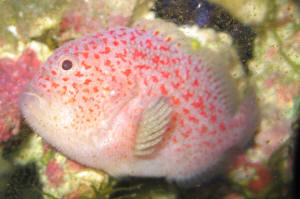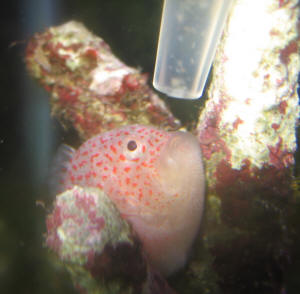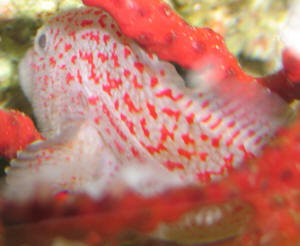Scorpionfishes:
Lionfishes & Much More for Marine Aquariums
Diversity, Selection & Care
New eBook on Amazon: Available
here
New Print Book on Create Space: Available
here
by Robert (Bob) Fenner |
 |
Fish living inside Acropora
1/26/12
Hello Gang.
<Vince>
I recently purchased an Acropora about 5" in diameter.
Inside the coral there is a crab (your typical smooth shell crab that
usually comes with it). I also noticed there is a small purple
fish with black eyes hiding inside it. The fish is flat body
about 3/4" long. Is the fish harmful to the Acropora?
<Mmm, not likely... from the color, desc., is likely a
Caracanthid:
http://www.wetwebmedia.com/caracanthidae.htm
Should I remove it? I don't want to remove and risk
injuring the fish if it is harmless.
<I wouldn't remove... an interesting addition... is venomous if
you do intend to handle>
Thanks in advance.
Kind regards,
Vincent Cheung
<Welcome! Bob Fenner>
Re: Fish living inside Acropora 1/26/12
Hello Bob.
<Big V>
Thanks for the quick response.
<Welcome>
Yes the fish does resemble the Caracanthid now that you pointed me in
the right direction. I am surprised it is more related to the
lionfish then a goby.
<Neat eh?>
That was a lucky purchase to have a fish as well as a crab with the
Acropora. Thanks for the heads up on the venomous part.
<Who said heads up?! Huh, I'll take some of that!>
Regards,
Vincent
<And you, BobF>
| Velvetfish 6/13/08 Hello, Bob,
<Felicia> Just thought you might want a better photo of my
velvet fish, Caracanthus madagascariensis. <Ahh, thank you> I
went to IMAC this year and specifically set out to meet you. I
informed everyone to introduce us if you were spotted. You were
sitting at the table next to us (seahorse.orgers) at the banquet
and I planned to introduce myself afterward, but you had already
left. Figures! Next conference :) <Rats! I thought my head was
going to explode with TomF's talk on the falsity of global
warming... Sheesh! Do be more old please next time we're near!
Cheers, Bob Fenner> |
|
 
|
| Turkish anemone ID and Velvetfish
info 2/2/08Hello Crew, <Felicia> Thank you
for your website. I go here every day, it is very helpful to me.
<Ah, good> I have been trying to ID this anemone for months.
These photos was taken by a friend in the Sea of Marmara. He asked
me to ID it, and I have no clue! Can you help? <I wish I had my
copy of Helmut Debelius "Mediterranean and Atlantic
Invertebrate Guide"... Do look for this work:
http://www.nhbs.com/mediterranean_and_atlantic_invertebrate_guide_tefno_131276.html
am pretty sure I've seen this distinctive pedicle before...>
And for your Velvetfish page, I thought you might like to post one
of my photos. This is my Caracanthus madagascariensis. <Thank
you for this. Will post with credit to you> He lives in my 55
gallon aquarium with some small gobies and pipefish and
miscellaneous inverts like corals, small crabs, and a squat
lobster. He hides constantly. I've heard they may eat small
fish, but he hasn't eaten anyone, yet. He is very easy to feed,
not picky, I feed Cyclops, mysis, etc. I don't feed pellets,
but I bet he would eat them. I'm definitely more careful about
where I put my hands, but I'm not overly worried that he will
sting me. Even though he rarely moves, I really enjoy watching him.
<Thank you for sharing. Bob Fenner> |
 |
Orbicular Velvetfish... gen. husbandry 2/27/07 Hi
Bob and company! I am writing with more of a fishkeeping experience
rather than a question, but I hope perhaps something I say can be
useful to someone else. <Good> A few months ago I purchased a
Hawaiian Orbicular Velvetfish (Caracanthus typicus). <Man! I wonder
how folks get these out of the Pocilloporids there?> At first I had
a great deal of difficulty locating any information for this species...
in fact, I still don't know a whole lot about them. Here is what I
DO know: This fish is doing fantastic in my tank. I have Marshall
Island live rock with a good number of crevices and this fish spends
the majority of its time holed up inside there, I would guess because
its natural hiding spot is wedged inside Acropora coral. <More
Cat's Paw in HI... little Staghorn coverage in the principal
islands> This fish has not bothered any of the corals, fish or
invertebrates in the tank (including a sand dwelling watchman goby and
several small hermit crabs). The fish is more active at night... I
think the bright light and quick movements during the day frighten him.
He is a voracious eater. I have moved to feeding him small sized prawn
(body only) and this seems to satiate him. Otherwise I think he could
easily eat more Cyclop-eeze than my water quality would allow! I feed
him using a long bulb syringe and he has become accustomed to leaving
his little crevice and taking the food right from the tip or the
syringe, <Neat> then quickly darting back into the rock. The fish
often hangs upside down or perfectly vertical, I would think in a
manner as to keep an eye out for passing prey while maintaining a
stealthy appearance. <Plus avoiding predators... attention> I
have found this fish to be an interesting and conversational addition
to my tank. The fish requires a bit extra work. As I said, I spot feed
the fish which takes a bit of time and effort, and I do feed him hearty
amounts. The fish is not a visible one and it won't make a
"showpiece" fish as it will largely stay hidden from view.
Although it has been peaceful in my tank I can indeed picture this
little guy scooping up a very small goby or invert that wandered too
close to its hiding spot. For completeness sake I should mention that I
have seen this fish listed at online retailers as a "gum drop
goby" but I don't think this fish has any relation to the
Gobioids family. <Correct... is a Scorpaeniform...> So if someone
is looking for an interesting but elusive fish, and they don't mind
sacrificing some potential tissue loss on their acros (or they just
supply it with some holey live rock) then I think this critter is worth
reading up on and keeping an eye out for. I truly feel it is worth the
extra effort to keep such an odd and unique fish. Thanks! <Thank you
for this input. Bob Fenner>
Caracanthus typicus 1/21/06 Hello WWM crew.
Just
a quick question please. I saw a rather interesting little fish in my
LFS today. They had it labeled as 'Red spot coral goby',
<Mmm, not a goby, gobioid... but a relative of
lionfishes/scorpaenoids, a Velvetfish: http://fishbase.org/Summary/speciesSummary.php?ID=52705&genusname=Caracanthus&speciesname=typicus>
said it was reef safe, similar in habit to some of the Hawkfishes but
more nocturnal, and grew to about 5cm. I generally dislike common names
as they're so inaccurate, several fish being given the same name
and increasingly silly names to make fish sound more attractive! More
research has found that I think it's in fact a type of scorpion
fish, Caracanthus typicus from Hawaii - known as the 'Red spot
coral croucher', or 'Hawaiian Velvetfish' - also that it is
venomous like many in it's family! <Yes... almost impossible to
photograph... stuck in Pocilloporid coral... and how did they collect
it?> My question(s) really is as
follows. Is this fish dangerous venom wise, <Mmm, not practically...
Unless you were to catch it and squeeze it big-time in your hand>
and is it reef safe ? <Mmm, yes...> It did seem to have a big
mouth, but was a small fish. I'm just trying to find out as much as
possible before considering adding it to my reef tank, as in a previous
incarnation I was a collector of weird freshwater catfish and this
little chap had a lot of their finer characteristics !
Thank
you for your time.
Bob
Mehen, Cornwall UK. <Have seen these many times (in Hawai'i),
and a few times in captivity (my pix on WWM)... know little re their
captive husbandry. Cheers, Bob Fenner>
Scorpionfishes:
Lionfishes & Much More for Marine Aquariums
Diversity, Selection & Care
New eBook on Amazon: Available
here
New Print Book on Create Space: Available
here
by Robert (Bob) Fenner |
 |

